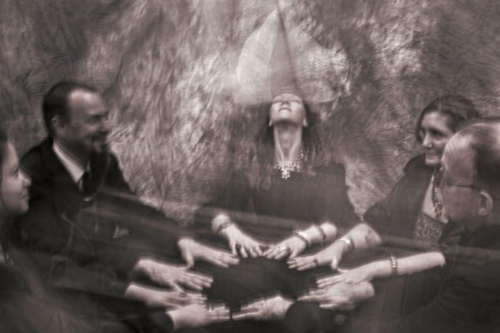
Following the success of the inaugural Science and Spiritualism Conference at Leeds Trinity University on Thursday 30 and Friday 31 May, historian and conference attendee Andreas Sommer has written an opinion piece about his experience at the event. Andreas can be found on Twitter via @Sommer_HPS.
If you saw the call for papers and extended abstract of my presentation, you can imagine how much I was looking forward to last week’s conference on the history of science and spiritualism at Leeds Trinity University. In fact, the last time I was so excited about a conference was in 2013, when I organized a similar meeting myself. This was a three-days conference on psychical research in the history of science and medicine at University College London, which resulted in a guest-edited special section in the journal Studies in History & Philosophy of Biological & Biomedical Sciences in 2014. Whereas the UCL meeting had a stronger focus on the modern occult in intellectual and social histories of the sciences and related historiographical issues, perhaps most papers presented at Leeds came from literary scholars and researchers in related fields. Common to both conferences, however, was a wide international scope as well as a high level of quality of talks.
According to a notice by the organization committee, The Victorian Web are intending to upload a selection of abstracts specifically addressing Victorian topics on their website. But since the scope of papers was rather broad, it seems many contributions to this wonderful conference may soon be little more than traces in the cosmic ether. However, there was a conference Twitter hashtag #scispi, and though not nearly all Twitterstorians among the presenters knew of it or were covered, this link taking you to the conference’s Twitter feed will nevertheless provide you with some great impressions and snapshots.
Originally initiated by Efram Sera-Shriar (now at the Science Museum, London) when he was still at Leeds Trinity, the conference was mainly organized by his colleagues Profs. Rosemary Mitchell and Jane deGay. Supported by a team of student volunteers, Rosemary and Jane were looking after us with enormous warmth and patience, and I was particularly grateful to the organization team for offering conference fee waivers and bursaries to unwaged presenters, which helped offset travel and accommodation costs.
On day one, delegates were invited to participate in an immersive parlour séance, which was dramatically re-enacted by performance artists and magicians Ashton Carter and Nik Taylor. We got to try our luck at the pendulum, and a handful of delegates were called forth to operate a Ouija board-style moving glass and to witness other supposedly occult feats. The “spirits” (or rather Efram as he confessed to me afterwards) advised Ashton and Nik to cast me as the sceptic, and as expected my very presence inhibited some of the more spectacular “phenomena” not easily explainable in terms of subconscious conformity, ideomotor movements and other psychological effects. I certainly did my worst to be an obnoxious wisenheimer, and while there was some “spirit writing” inside a set of slates and other minor phenomena, it was probably only my enlightened scoffing that prevented materializations of spirit forms.
Both days were long, and given the sheer number of papers, parallel sessions were inevitable. The conference committee selected talks on the basis of submitted abstracts, so it was a pity that only abstracts of the two keynote lectures by Christine Ferguson and Roger Luckhurst (included in the programme) were made available to delegates. After all, the title of a talk can only convey so much information, and the lack of abstracts and biosketches made it quite hard to inform decisions of which presentations to attend. For example, I thought I might well be the only historian currently working on the German philosopher and spiritualist Carl du Prel (1839-1899). Imagine my delight and surprise when I realised that Tetsuya Kumagai of Kindai University in Osaka, Japan, has also extensively researched du Prel, which however I learnt only because I happened to chair Tetsuya’s session.
In terms of networking opportunities, I was also a little disappointed that the only other paper explicitly related to the history of “naturalism” – Bill Jenkins’ talk on physiological accounts of apparitions – was given in the parallel panel to my own talk. Hence, Bill and I had to use a couple of the rather short breaks between sessions to fill each other in about our research, and to ventilate initial ideas about a possible project on the history of scientific naturalism.
Decisions to pick one talk or session over the other were never easy, so apart from missing abstracts it was unfortunate that there was also no list of speakers’ email addresses. Not every presenter is easily “googable”, and an email list would have been useful to request abstracts or further information from speakers whose papers one had to miss.
Still, this was a great and memorable conference with too many interesting and inspiring papers to count, and it was wonderful to reunite with old colleagues and friends while making new ones. Rosemary, Jane, Efram, and the student helpers who organized this unique and highly enjoyable conference, deserve the gratitude of all delegates and presenters.
Andreas Sommer is a historian of science and magic and University College London alumnus. Andreas was a post-doctorate researcher at Cambridge University (2013 - 2017) and is the founder of the Forbidden Histories webpage and Facebook page.